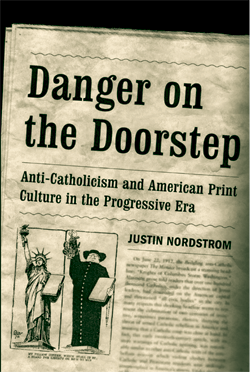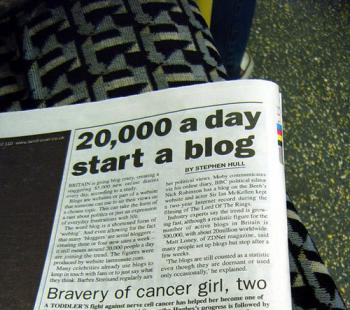Archbishop Dolan blogs on the Gray Lady
 Well, The New York Times may get Judaism, it might not get Hinduism, but does it get Catholicism? Archbishop Timothy Dolan of New York has decided to use recent articles from the Gray Lady to show how Americans -- especially journalists in his zip code -- are anti-Catholic. Needless to say, this was an op-ed article that Fox News was happy to publish, while the Times declined to do so. As Gary Stern notes, Dolan is precise in his critique, offering specific examples of his frustrations, which is more helpful to reporters than criticizing the mass media as a whole.
Well, The New York Times may get Judaism, it might not get Hinduism, but does it get Catholicism? Archbishop Timothy Dolan of New York has decided to use recent articles from the Gray Lady to show how Americans -- especially journalists in his zip code -- are anti-Catholic. Needless to say, this was an op-ed article that Fox News was happy to publish, while the Times declined to do so. As Gary Stern notes, Dolan is precise in his critique, offering specific examples of his frustrations, which is more helpful to reporters than criticizing the mass media as a whole.
Dolan first looks at an Oct. 14 story in the Times about 40 cases of child sexual abuse that took place in Brooklyn's Orthodox Jewish community during the last year. He argues that the reporter did not dig for more details the same way reporters have pursued with the Catholic abuse cases.
Yet the Times did not demand what it has called for incessantly when addressing the same kind of abuse by a tiny minority of priests: release of names of abusers, rollback of statute of limitations, external investigations, release of all records, and total transparency. Instead, an attorney is quoted urging law enforcement officials to recognize "religious sensitivities," and no criticism was offered of the DA's office for allowing Orthodox rabbis to settle these cases "internally." Given the Catholic Church's own recent horrible experience, I am hardly in any position to criticize our Orthodox Jewish neighbors, and have no wish to do so ... but I can criticize this kind of "selective outrage."
Needless to say, it's probably pretty motivating for reporters to pursue the Catholic church angle when entire dioceses are filing for bankruptcy. Regardless, Dolan makes a good point: Reporters should use the same vigor to pursue the names of abusers and call for transparency when reporting this kind of abuse case.
Dolan's second point examines Laurie Goodstein's Oct. 16 front page, above-the-fold story on a Franciscan priest who fathered a child.
... one still has to wonder why a quarter-century old story of a sin by a priest is now suddenly more pressing and newsworthy than the war in Afghanistan, health care, and starvation-genocide in Sudan. No other cleric from religions other than Catholic ever seems to merit such attention.
You could probably use this argument with just about any story the Times puts on its front page, since the stories with the most global impact don't necessarily make it above the fold. Dolan's argument that a cleric from another religion probably wouldn't merit such attention is probably true, considering Catholics make up about 24 percent of the country (versus, say, 1.7 percent who are Jewish). Protestantism often seems too fragmented for individual Protestants to become interested in a pastor's scandal if it doesn't involve their own church.
Third, the Times reported that the Vatican is welcoming Anglicans to join the Catholic Church (an article that tmatt mostly praised). Dolan picks apart the lead, where Laurie Goodstein begins: "In an extraordinary bid to lure traditionalist Anglicans en masse. ..."
Unfair, though, was the article's observation that the Holy See lured and bid for the Anglicans. ... for [The Times], this was another case of the conniving Vatican luring and bidding unsuspecting, good people, greedily capitalizing on the current internal tensions in Anglicanism.
Choosing the word "lure" seems fairly accurate to me, since it's not every day that Pope Benedict XVI paves the way for another tradition to join the Catholic Church, right? Then again, some Anglicans had been seeking his help for more than a decade.
 Finally, Dolan says a piece by Maureen Dowd would not have passed muster with the editors if it had criticized an Islamic, Jewish or African-American religious issue.
Finally, Dolan says a piece by Maureen Dowd would not have passed muster with the editors if it had criticized an Islamic, Jewish or African-American religious issue.
True enough, the matter that triggered her spasm -- the current visitation of women religious by Vatican representatives -- is well-worth discussing, and hardly exempt from legitimate questioning. But her prejudice, while maybe appropriate for the Know-Nothing newspaper of the 1850's, the Menace, has no place in a major publication today.
Perhaps that's some food for thought for the op-ed department to consider, but we'll stick to the news for now.
The Times has covered Dolan several times in the last several months since he was named to as archbishop of New York in April (he gets his own topic page).
Dolan doesn't appear to be critical of all media, however. Just last week, Dolan told the National Catholic Register that the media in New York have been "exceptionally attentive" since his installation. "They have been interested in what I have to say, they have joined in the chorus of welcome, and I can't keep up with the requests for interviews and articles and appearances," the archbishop told the reporter. So far, Dolan's critiques appear to be focused mostly on the Times.
The story began on Dolan's new blog, so I find it fairly ironic that on the same day he posted his critique, the Times offered a pretty positive piece about the blog titled "Archbishop Dolan Is Blogging. Keep the Comments Clean." (Is it really still a big deal that people start blogs? the Times seems to think so -- if it's the Archbishop of New York.)
Newspapers shouldn't try to fill a positive story quota, but surely there are more compelling stories of the Catholic Church doing good (and interesting) deeds than the archbishop's new blog.
First photo courtesy of University of Notre Dame Press. Second photo courtesy of Annie Mole.